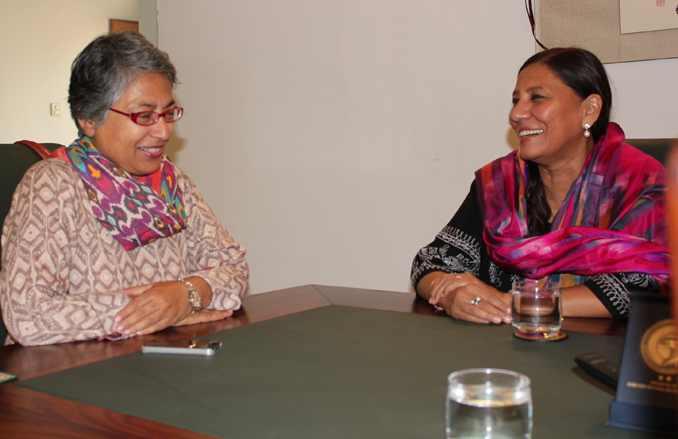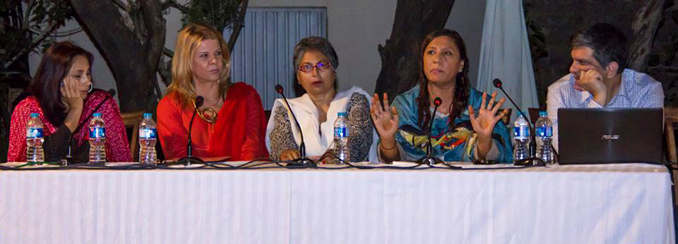Written by: Sabahat Afsheen and Dr. Dushka H. Saiyid - Posted on: November 05, 2014 |  Comments | 中国 (Chinese)
Comments | 中国 (Chinese)
Google Translation: اُردو | 中文
While everyone talks about a better life for the elite, Imrana Tiwana is the voice of the people and talks about community issues, a healthy environment and a balanced urban development. Youlin interviewed Imrana Tiwana for the Ecowatch section.
She declares, “I am an architect by profession but an environmentalist by heart. Actually there is a heart and soul connection between architecture, urban development and environment. The interdependence of these three is what makes the society work in an organized way.”
After graduating from the National College of Arts, Lahore, Imrana went to Massachusetts Institute of Technology (MIT) for graduate studies on an Aga Khan Scholarship. She headed the MIT Environmental Design Forum, and completed 50% course work from Harvard University. An important lesson she learnt at these institutions was how to maintain a balance between research and application, necessary for successful corporate work. She was the first and only recipient of the Aga Khan Scholarship to be selected, among four other architects, by President of Malaysia, Mahatir Muhammad, to reassess the urban Malaysian planning. He wanted traditional architecture incorporated in the planning of Malaysia’s new cities, and their presentation about the feasibility of a new paradigm was accepted.
 |
The Editor interviews Imrana Tiwana |
After graduating she got an opportunity to work for Skidmore, Owings and Merill, the leading firm of architecture in New York. It was while working on the tallest building in the Battery City Park that she learnt about the integral link between architecture and citizenship, and how environment is the bridge between the two. They worked hard with the competitive attitude that they had imbibed at Harvard, only to discover that citizens of the area had filed a case against the construction of that building. Their concerns were environmental, that such a large building in the center of the city would block sun light to their homes. After months of legal wrangling in the courts, the citizens of Battery Park won, and the building was never made. This changed her perspective on urban development, and the need for local communities to have a say in decisions that affect their neighborhood. Reflecting on our own political system, she voiced her concern that unfortunately our people were voiceless. She was also part of the team that was involved in the “cleaning up” and redevelopment of Times Square in New York.
She headed home after gaining work experience in New York, turning down the offer to join the Board of Agha Khan Award. She founded the firm Imrana-Mansoor and Associates in Lahore, and did many commercial projects such as Hush Puppies, Pizza Hut and banks. She also found time to teach at her alma mater, the National College of Arts, for three and a half years.
At a chance encounter with Mr. Shahbaz Sharif, the Chief Minister of Punjab, when she mentioned to him that people in our country were unaware of how closely interlinked architecture, urbanization and environment were, he immediately appointed her as the head of the Task Force on Urban Development in Punjab. Being an outsider, the bureaucracy created all sorts of hurdles for her and she was not paid for a year. However, she kept working on all the projects, and when after a year she presented her work to Shahbaz Sharif, he was very appreciative of her input, but unfortunately the government was over thrown soon.
Her second baptism in dealing with the state institutions came at the start of the Musharraf era, when the Punjab High Court Building’s eastern wing was demolished overnight for the construction of an extension. But since that building was listed as an architectural heritage site, no construction could legally take place in the 400 yards vicinity of it. Since Imrana was the President of Institute of Architects, Pakistan, she gathered all the renowned architects of Lahore and started a movement against its demolition. When the media tried to cover their demonstration, the reporters were beaten and their cameras broken. The architects association compiled all the relevant data and sent the complaint to Pervaiz Musharraf, who responded by advising the Registrar of the High Court to seal the area, stop the work and hold an inquiry. The inquiry committee had been meeting for three months, when the Chief Justice of the Supreme Court took suo moto action and advised the hearings to take place in the Supreme Court. Aitzaz Ahsan took up the case pro bono, and three months later the Supreme Court gave the decision that all debris must be used to reconstruct the building, which must be restored to its original form. This group of architects also gave 70-80 years development plan for the Lahore High Court, but that was not to be, as one night the angry Chief Justice of the Lahore High Court had one of the wings demolished in clear violation of the Supreme Court orders. However, that was stopped, and the loss of an invaluable heritage building averted. Imrana had learnt that activism could pay dividends.
 |
Imrana at a discussion of the Metrobus Project at Kuch Khaas |
A major assault on the environment of Lahore came in 2006 when the Government of Punjab decided to widen the Canal Road from Thokar Niaz Baig to Jallo Park. There is a 2000-acre green belt along the Canal and they wanted to cut all the trees and build a motorway along it. Imrana was one of the activists who started a tehreek (movement) that was initially called Darakht Bachao Tehreek (Movement for Saving the Trees), but later its name was changed to Lahore Bachao Tehreek (Movement to Save Lahore), because this City of Gardens was being turned into a City of Hospitals with the destruction of such a large green belt, the lungs of the city. She declares that Lahore is being developed in an ad hoc manner, and what is required is Smart Integrated Sustainable Management of Cities. She voices her concern that the degradation impacts are irreversible to the environment, citizens and to the country, a self-destructing bomb. “Who is this development for, since only 7% of the population use cars, but what about the rest of the 93%? When all seemed lost, Chief Justice Iftikhar Muhammad Chaudhry took suo moto notice of the issue, and Aitzaz Ahsan took up our case pro-bono.” In 2011, a landmark judgment was given which said that only 1.5 km of the 3.25 km area along the canal will be widened and declared the Canal to be a public trust and Urban Heritage Park. The Punjab Assembly also passed the Canal Heritage Act in 2013. However, the Government of Pakistan continues to violate the Supreme Court orders in one way or the other, and she, as the convener of the Tehreek, continues the battle.
Imrana is a leading environmentalist of Lahore, who says, “We are the voice of the people, and we want governance in accordance with the rule of law. Development is meaningless without a sense of well being of citizens. Countries cannot be sustained on the whims and ad-hocism of those in power. Citizens Participatory Democracy is a prerequisite for good governance.”